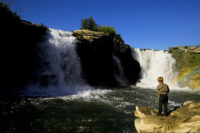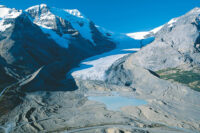City dive team receives high praise during recertification
By Al Beeber - Lethbridge Herald on September 9, 2022.
 Herald photo by Al Beeber
Andrea Zaferes, in white jacket and toque, supervises training of dive team members and their tenders Thursday at the Riverstone pond. The Lethbridge Fire and Emergency Services team was undergoing recertification training which occurs every three years.
Herald photo by Al Beeber
Andrea Zaferes, in white jacket and toque, supervises training of dive team members and their tenders Thursday at the Riverstone pond. The Lethbridge Fire and Emergency Services team was undergoing recertification training which occurs every three years.LETHBRIDGE HERALDabeeber@lethbridgeherald.com
Every three years, the dive team of Lethbridge Fire and Emergency Services undergoes a recertification course.
On Thursday under the watchful eye of New York-based Andrea Zaferes who was conducting the course, the 13 divers and their 11 tenders got that training at Riverstone Pond on the westside.
Tenders are shore-based team members who collaborate with the divers in their search for bodies or evidence under water.
And as Lethbridge dive team leader Brendon Pyne said Thursday, much of the team’s work involves recovery. That work is often in turbid water with zero visibility requiring team members to rely on touch as they scour the bottoms of lakes and rivers.
Zaferes, vice president of Lifeguard Systems Inc., is a medicolegal investigator for Dutchess County in New York state.
She is one of the leading trainers in the international water rescue and recovering industries, conducting courses in the U.S., Canada and other countries. She is also an author and expert legal witness for diving who helps law enforcement with drowning homicide investigations.
She said the Lethbridge team is one of her favourites to work with.
“We are training one of our favourite teams in the entire world, which is Lethbridge. They are just amazing; they have the best attitudes ever, they work non-stop,” she said.
The purpose of the training is to teach divers how to find bodies and evidence in the water in recovery and rescue modes, she said.
Zaferes said her mentor and partner Butch Hendricks started the system which applied science to searching in the 1960s.
“Every move a diver makes is being recorded on paper, their breaths per minutes are being recorded every five minutes because if they’re having stress we know they’re not searching well and that would be demonstrated with them breathing high.
“We’re covering everything in a very methodical, slow eyes-closed (manner) because you can’t see anything down there.”
Unfortunately, she said, more divers have died than drowning victims have been saved by divers.
“That number’s not good.”
Training is done every three years because course operators are “always learning new things as well. If there’s a fatality we study what happened and we try to make our system even more safe,” Zaferes added.
Divers are also taught how to document things “so if there is a crime involved that they’re court-ready.”
Today, city police will be involved in a workshop about how to recognize and document then eventually prosecute aquatic abuse and homicide “because those are happening far more often than we think,” said Zaferes.
Drownings are some of the most misdiagnosed crimes because drownings are often treated like accidents, she said.
Drowning sites need to be treated as crime scenes like all bodies found on land, she added.
Everything is done underwater by feel with every part of a diver’s body being sensitive to touch. They can even find a body with a fin tip.
“They have to be on alert” so maximum dive time is 25 minutes, she said.
“It’s very methodical and slow.”
Zaferes said drowning is the number one cause of unintentional accidental death among kids aged one to four and is in the top 10 causes for all age groups. Men are four times more likely to drown than women.
She said there are two types of drowning victims.
Non-swimmers who are drowning are pretty easy to spot because they will flail unless they’re negatively buoyant and go under water quickly.
Poor swimmers who start drowning look a bit different – all that can be seen is their heads and they can’t yell because they’re just trying to breathe, she said.
Drownings can be avoided by using a “water accountability card” that is put on a lanyard and having people taking turns for 15 minutes watching swimmers.
“That would save a lot of lives because we have videos upon videos where people are all around the drowning victims and nobody notices them.”
She said someone needs to count people in a pool or a lake and nobody should enter the water to help a person drowning unless he or she is a lifeguard.
“Hundreds of people will drown trying to save someone else.”
Anything that floats can be given to a person who is drowning but she says nobody should get within arm’s reach of a person drowning.
“Two dead are never better than one.”
Dive team member Nicholas Spencer said there is “a lot to learn in a small period of time. Luckily we have a lot of really good divers here” who will pull members aside to show them what they’re doing wrong, and right, and help each other be the best diver they can be.
Follow @albeebHerald on Twitter
36-35




